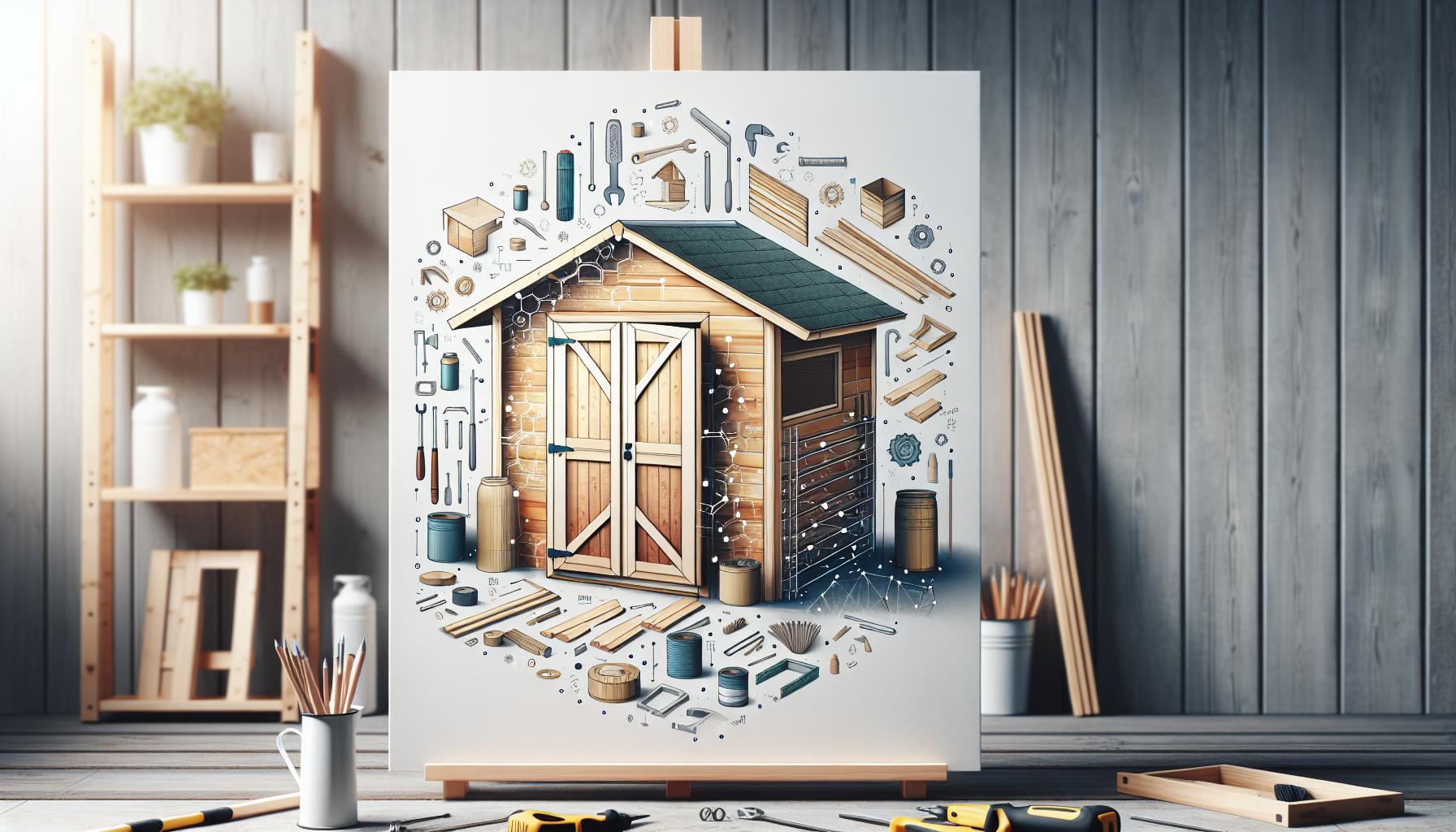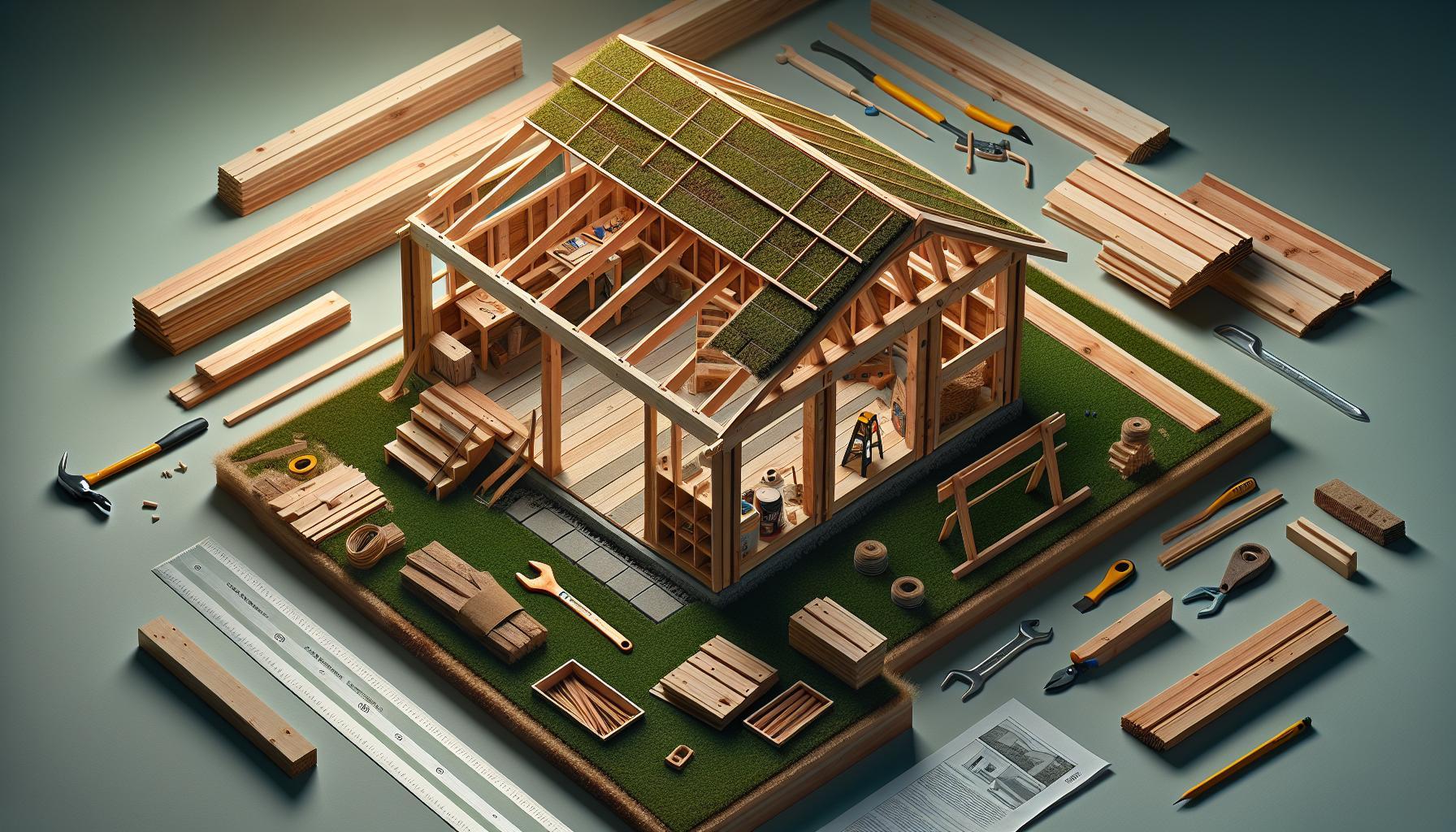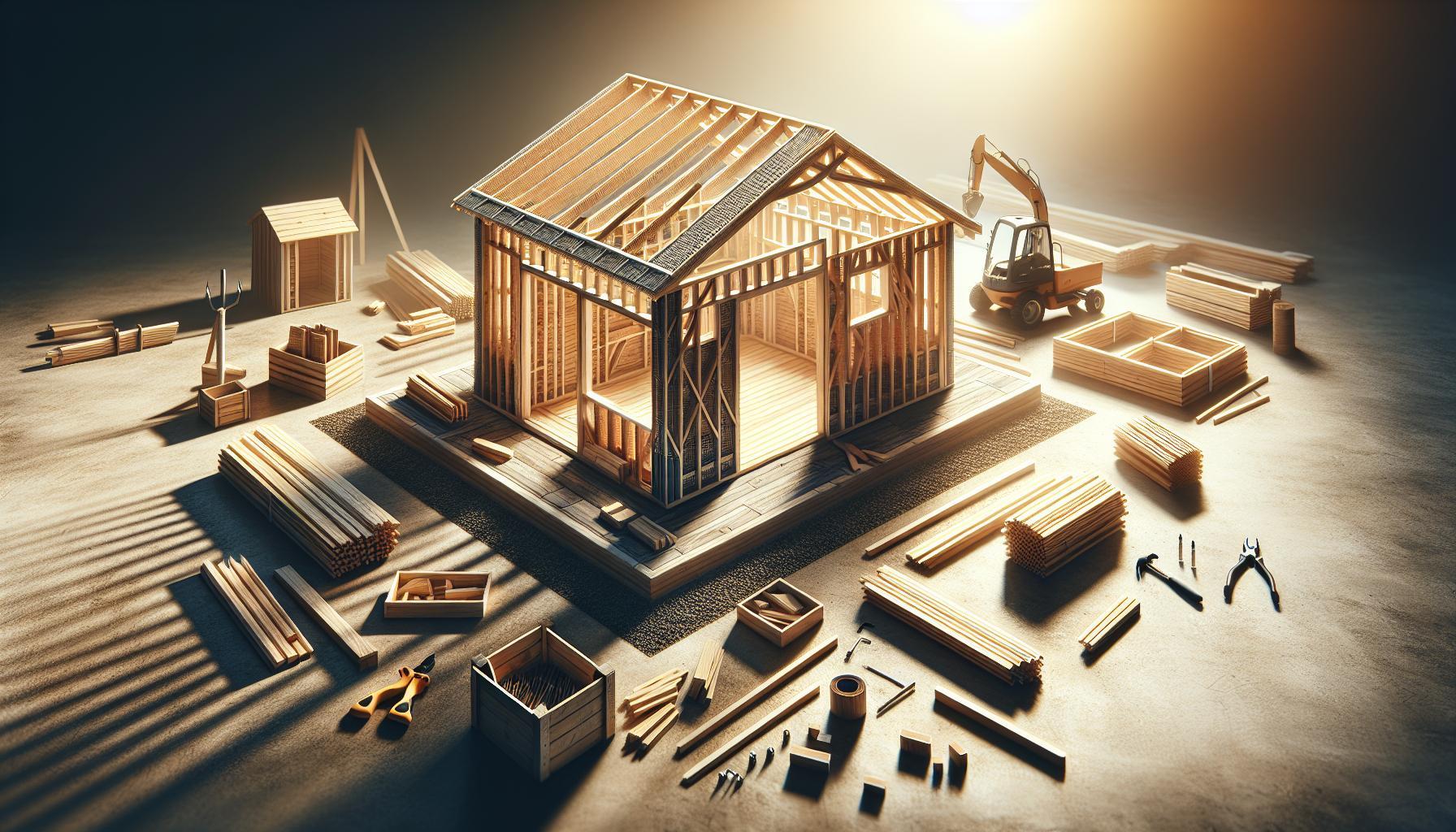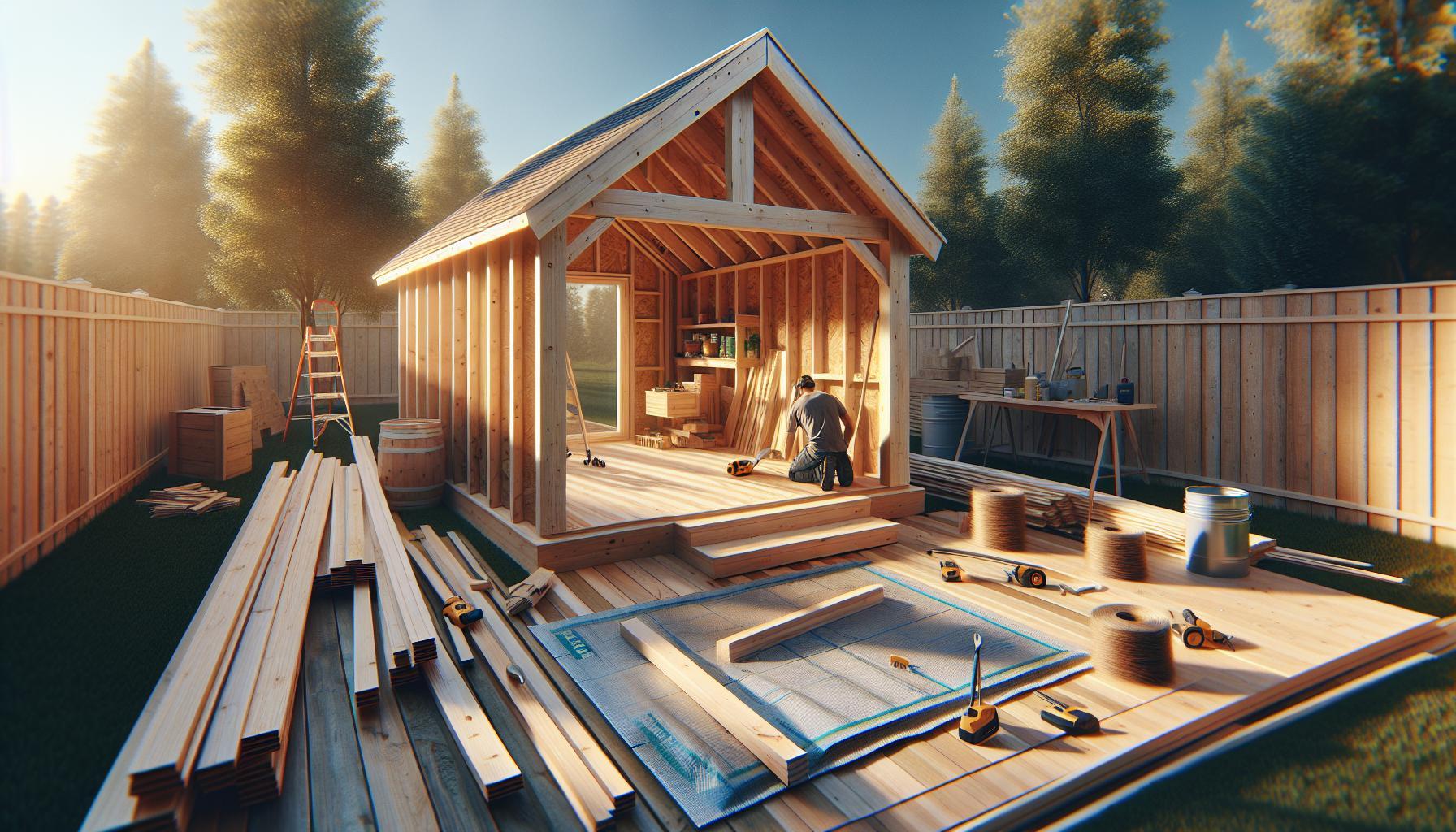Struggling with flimsy, unappealing shed entrances? A well-built door not only secures your tools and equipment but also enhances your outdoor space’s aesthetic. In this guide, we’ll walk you thru creating sturdy and stylish shed doors that provide both functionality and flair, making your shed a standout feature in your garden.
Choosing the Right Materials for Your Shed Door
Selecting the appropriate materials for your shed door can significantly impact not just its functionality, but also its aesthetic appearance and durability. With many options available, understanding what each material brings to the table will help you create a secure and stylish entrance that complements your shed’s overall design.
common Materials for Shed Doors
When deciding on the materials for your shed door, consider the following common options, each with its unique attributes:
- Wood: A popular choice for shed doors, wood is versatile and offers a classic look.hardwoods,like oak or mahogany,provide strength and durability,while softer woods,such as pine or cedar,may be more affordable but will require additional maintenance over time.
- Metal: Steel or aluminum doors are incredibly strong and resistant to the elements, making them an excellent choice for security. They can be painted or finished to match the exterior of your shed, providing both durability and aesthetic appeal.
- composite Materials: These are engineered from recycled wood fibers and plastic, combining the best qualities of both. They resist rot, are low-maintenance, and come in various styles and colors, allowing you to customize your shed door while ensuring longevity.
- Fiberglass: this material is known for its high resistance to weathering and can mimic the look of wood.Fiberglass doors are lightweight and often more energy-efficient but may require a higher initial investment.
Factors to Consider
When choosing the right material, consider the following factors:
| Factor | Wood | Metal | Composite | Fiberglass |
|---|---|---|---|---|
| Durability | Moderate—depends on maintenance | High—weather and damage resistant | High—resistant to rot and pests | high—weather resistant |
| Security | Moderate—can be reinforced | High—very tough to break through | Moderate—can be reinforced | Moderate—less secure than metal |
| Cost | Variable—can be affordable or pricey | Moderate to high—depends on thickness and finish | Moderate—competitive pricing | High—initial investment is often higher |
| Aesthetic Adaptability | High—natural beauty and customization | Moderate—mostly industrial looks | High—many styles available | High—can mimic wood with modern finishes |
By weighing these various materials against your specific needs, such as the climate in your region, how much wear and tear you expect, and the overall design of your shed, you can confidently make a choice that aligns with the objectives outlined in ‘How to Build Shed door: Create Secure & Stylish Entrances Easily.’ Remember, a well-chosen material will not only enhance your shed’s appearance but also provide the necessary security and resistance against the elements, ensuring your investment lasts for years to come.
Essential Tools You Need for a Successful Build
Creating a shed door that is both aesthetically pleasing and functional requires not only skill but also the right tools. When embarking on a project like this, having a well-equipped toolkit can make a notable difference in the efficiency and quality of your work. The following are essential tools that will help ensure a successful build,allowing you to create a secure and stylish entrance for your shed.
Must-Have Tools for Building Your Shed Door
To get started on your shed door project, make sure you have the following tools at your disposal:
- Measuring Tape: Accurate measurements are crucial when building a door. A retractable measuring tape will help you ensure precise dimensions.
- Miter Saw: This power tool will allow you to make clean, angled cuts on your wood pieces, essential for creating a door that fits perfectly.
- Drill and Drill Bits: A reliable drill is indispensable for making holes for screws and hinge installations. Make sure to have a variety of bits for different sizes.
- Screwdriver Set: A set of screws and the right screwdrivers will ensure you can secure the door properly.
- Level: To make sure your door hangs straight, a level will help you align it correctly during installation.
- Adjustable wrench: This can be very useful for tightening bolts and ensuring all components are secure.
- Safety Gear: Protective eyewear and gloves are essential to keep you safe while working.
Investing in these tools not only simplifies the construction process but also enhances the durability of your finished product. Each tool serves a purpose — from ensuring accurate cuts to providing the necessary assembly and finishing touches.
Optional Yet Helpful Tools
If you want to take your shed door project to the next level, consider adding the following optional tools to your collection:
- Router: A router can be used to add decorative edges or grooves to your door panels, increasing visual appeal.
- Orbital Sander: For a smooth finish, an orbital sander can save you time on sanding down wood surfaces.
- Clamps: Having a set of clamps can secure your pieces in place, making it easier to drill and attach components.
These tools can elevate your build quality and provide additional features that enhance both functionality and design.
gathering the right tools is essential when you want to execute a project like constructing a shed door with both security and style. By preparing adequately, you will be set to tackle any challenges that may arise during the building process, ultimately contributing to a successful outcome that meets your aesthetic and practical needs.Remember, preparation is key in ensuring that your vision for a stylish entrance becomes a reality!
Step-by-Step Guide to Measuring and Cutting Door Panels
A well-constructed door panel not only adds to the aesthetic appeal of your shed but also provides a robust entry point that can withstand the elements. Understanding the process of measuring and cutting these panels accurately is crucial to achieving a successful build. Below, you’ll find a extensive approach to ensure that your shed door complements the overall design while providing functionality and security.
Preparation: Gather Your Tools and Materials
Before you embark on the measuring and cutting process, gather the necessary tools and materials. Having everything at hand will streamline your workflow and minimize errors. Here’s what you’ll need:
- Measuring tape
- Pencil or chalk marker
- Square
- Level
- Saw (circular saw or table saw recommended)
- Safety gear (gloves, goggles)
- Wood panels (choose your preferred material)
Measuring Door Panels accurately
Accuracy is paramount when measuring your panels. Follow these steps to ensure you get it right:
- Determine the Size of Your Opening: Measure the width and height of the shed door opening, ensuring you note down both dimensions. It’s wise to measure at multiple points as openings can sometimes be irregular.
- Adjust for Clearance: Subtract about 1/2 inch for the width and height from your measurements.This margin allows the door to swing freely and accounts for any expansion in the wood.
- Mark Your Cuts: Using the measuring tape, mark the dimensions on your wood panels with a pencil. Employ a square to draw straight lines for accurate cuts.
Cutting Door Panels with Precision
Once you’ve properly measured and marked your panels, you can dive into the cutting process. Adhering to safety guidelines and utilizing the right cutting techniques ensures clean edges and a professional finish:
- Safeguard Yourself: Wear protective eyewear and gloves to safeguard against any potential accidents.
- Position the wood Securely: Place your wood on a stable surface, ensuring it is secure to prevent movement while cutting.
- Make the Cuts: Using your saw, carefully follow the marked lines. Take your time to avoid mistakes, and let the saw do the work instead of forcing it.
- Check for Straight Edges: After cutting, use a level to ensure the edges are straight. Any imperfections can be sanded down.
Final Touches: Sanding and Fitting
Once all your pieces are cut, it’s time for some finishing touches:
- Sand the Edges: Use sandpaper to smooth out any rough edges. This step is essential for preventing splinters and ensuring a pleasant finish.
- Dry Fit the panels: Before permanently attaching any hardware, place the door frame in the opening to check for proper fit.
- Make Adjustments: If necessary, make slight adjustments to your panel dimensions to ensure a snug fit.
By following these detailed steps,you’ll not only enhance your skills in building a shed door but also create a secure and stylish entrance that will stand the test of time.
Crafting a Secure Locking mechanism for Safety
Creating a reliable locking mechanism is essential for ensuring the safety and security of your shed.A well-constructed door not only adds style to your exterior but also safeguards your valuable tools and equipment from theft and damage. To optimize your shed’s security, it’s crucial to consider various options for locking mechanisms that can complement your design while providing peace of mind.
Types of Locking Mechanisms
There are several locking mechanisms you can choose from when building your shed door. Selecting the right type depends on your specific needs and the materials you’re using. Here are some popular options:
- Deadbolts: These are robust locks that provide enhanced security. They require a key to operate and are ideal for preventing unauthorized access.
- Padlocks: A versatile option where you can use a hasp to secure the door. Padlocks can be easily removed and replaced, offering flexibility.
- Sliding Bolt Locks: Commonly used for shed doors, these locks slide into place and can be secured with a padlock, adding an extra layer of protection.
- Combination Locks: Great for multiple users, combination locks eliminate the need for keys while providing an easily remembered access code.
building Your Locking Mechanism
When crafting your locking mechanism, consider these critical steps:
- Assess Your Shed’s Design: Depending on whether your shed door swings open or slides, choose a locking system that fits the opening style.
- Select Quality Materials: Utilize strong metals for locks and ensure they resist tampering. Lock components should be made of corrosion-resistant materials to withstand outdoor conditions.
- Installation Process: Follow these guidelines for effective installation:
– Mark the position for the lock accurately on the door frame.
– Drill holes with precision to prevent wood splitting.
– Ensure that your lock aligns perfectly with counterpart fittings to guarantee a tight seal when locked.
By opting for a high-quality locking mechanism, you not only enhance your shed’s security but also invest in long-term peace of mind. A combination of sturdy materials and careful installation goes a long way in crafting a durable locking system.
| Lock Type | Security Level | best Use Case |
|---|---|---|
| Deadbolt | High | High-value items |
| Padlock | Medium | Flexible access |
| Sliding Bolt | medium | Standard shed use |
| Combination Lock | Medium | Multiple users |
By implementing these strategies and selecting the right locking system, you can effectively fortify your shed against unauthorized access while ensuring it remains a stylish addition to your property.
Designing a Stylish Door that Complements Your Shed
When it comes to enhancing the overall appeal of your shed,the door is often an afterthought.However,a well-designed door not only provides functionality but also contributes significantly to the shed’s aesthetics,making it a focal point of your outdoor space. Imagine stepping into your garden or backyard and being greeted by a beautifully crafted door that complements the surrounding architecture and landscape. Here are some ideas to help you design a stylish entrance that harmonizes with your shed.
Choose the Right Materials
The choice of materials is one of the most crucial aspects of your shed door design. Depending on your shed’s primary use and the environmental conditions it will face, consider these materials:
- Wood: A classic option known for its warmth and versatility. You can choose from various types,such as cedar,which is naturally resistant to rot.
- Metal: A sturdy choice that offers security and durability. Steel or aluminum doors are excellent options for sheds used for tool storage.
- Composite: Made from a blend of materials, composite doors are resistant to moisture and require minimal maintenance.
Design Features to Consider
incorporating thoughtful design features can elevate the door’s appearance and functionality. Here are some popular options:
- Windows: adding small glass windows can create an inviting look while allowing natural light into your shed.
- Colour and Finish: A vibrant color or a natural wood finish can make the door pop against your shed’s exterior, enhancing its visual appeal.
- Hardware Accents: Decorative hinges and handles can add a touch of elegance.Opt for designs that match your shed’s style—rustic, modern, or vintage.
Simple yet Effective Design Ideas
You don’t need to sacrifice style for simplicity. Here are some easy-to-execute door designs that can enhance the entrance:
| Design Idea | Description |
|---|---|
| Double Doors | Provide a grand entrance and allow easy access,perfect for larger tools or equipment. |
| Sliding Barn Door | Ideal for a rustic look, sliding barn doors save space and add a unique flair to your shed. |
| Shaker Style | A clean, minimalist design that boasts a sophisticated look while being easy to construct. |
By carefully selecting materials and incorporating thoughtful design features, you can create a shed door that not only serves a functional purpose but also enhances the overall charm of your outdoor space. Investing in a stylish door will elevate your shed’s appeal and reflect your personal aesthetic, aligning perfectly with your vision on how to build a shed door that stands out while providing secure and stylish entrances easily.
Common Challenges in shed door Construction and How to Overcome Them
When embarking on the journey of constructing a shed door, enthusiasts may encounter a variety of challenges. Understanding these common hurdles not only strengthens the building process but also ensures that the final product is both functional and aesthetically pleasing. Effective strategies can help navigate these issues, transforming the task of building a secure and stylish entrance into an enjoyable DIY project.
Material Selection Dilemmas
choosing the right materials plays a critical role in the success of any shed door construction. Inadequate materials can lead to doors that warp, crack, or deteriorate prematurely. To combat this, consider the following:
- Durability: Opt for wood types like cedar or redwood, which are naturally resistant to rot and insects.
- Weight: Heavy materials may require additional support.Lightweight options like composite boards can reduce strain on hinges and frames.
- finish and Treatment: Use weather-resistant finishes to prolong the life of your door.
To assist in material choices, refer to the table below for a rapid comparison of commonly used woods and their properties:
| Wood Type | Durability | Weight | Cost |
|---|---|---|---|
| Cedar | High | Light | $$$ |
| Pine | Medium | Medium | $ |
| Redwood | High | Medium | $$$$ |
| Composite | Very High | Light | $$$ |
Precision in Measurements
Another significant challenge in the door construction process is achieving precise measurements. Even minor discrepancies can lead to misaligned hinges and gaps that jeopardize security or energy efficiency. Here are some strategies to maintain accuracy:
- Use a Level: Always ensure that your frame is level before taking measurements to prevent uneven cuts.
- Double-Check Cuts: Measure twice and cut once, as the classic adage suggests. This mitigates the risk of wasted materials and time.
- Templates: Create templates for consistent cuts, especially useful if you’re building multiple doors or panels.
Hardware and Installation Issues
Selecting the right hardware for your shed door is crucial. Low-quality hinges and locks may lead to malfunction, undermining the security of your shed. To address hardware challenges effectively:
- Choose Heavy-Duty Hinges: Invest in heavy-duty, rust-resistant hinges to ensure longevity and strength.
- Secure Locking Mechanisms: Consider slide bolts or padlocks for enhanced security; remember, it’s always better to over-engineer your security than to under-engineer it.
- Proper Installation Techniques: Follow manufacturer’s instructions and ensure that the hardware is installed at the correct height and orientation for smooth operation.
Facing these common challenges head-on with careful planning and execution will lead you to successfully create a shed door that combines security and style seamlessly.By equipping yourself with knowledge and employing these best practices, you can conquer any difficulties that arise in your quest to build a stellar entrance for your shed.
Finishing touches: Staining and Sealing for Durability
Creating a stunning shed door isn’t just about the construction; it’s also about how you finish it. The right stain and sealant can dramatically enhance the appearance and longevity of your door, ensuring it remains secure and stylish for years to come. As you embark on the final stages of your project, understanding how to properly stain and seal your shed door is essential for protecting it from the elements and adding a personal touch that reflects your style.
The Importance of Staining
Staining your shed door not only brings out the natural beauty of the wood but also serves as a protective barrier against moisture and UV rays. Here are some key benefits of applying stain:
- Enhances Aesthetics: A well-chosen stain can highlight the grain patterns and rich textures of the wood, making your door a focal point.
- Protects Against Weather: Stains often contain preservatives that guard against rot and decay caused by water exposure.
- Requires Less Maintenance: Unlike paint, stains often wear evenly and can be refreshed without complete removal, making upkeep simpler.
When selecting a stain, consider options such as oil-based or water-based formulations, each with different drying times and finishes. Oil-based stains typically penetrate deeper and provide a richer finish, while water-based options offer a quick drying time and easier clean-up.
Sealing for Ultimate Durability
Once your stain has dried and you’re satisfied with the color, the next step is sealing the door to extend its life even further. Sealants provide an additional layer of protection against moisture and wear. Here’s why sealing is crucial:
- Prevents Water Damage: Sealants form a protective barrier that helps prevent water from soaking into the wood, thus reducing the risk of warping or splitting.
- Enhances Scratch Resistance: A good sealant can guard against scratches and abrasions, keeping your door looking pristine.
- Maintains Color: Sealing helps maintain the integrity of the stain, preventing it from fading due to sun exposure.
For an effective seal,you can choose from a variety of products,including polyurethane,epoxy,or marine-grade sealants. Each option has its specific request requirements, drying times, and finishes, so choose one that best fits your needs and climate conditions.
Application Tips
Proper application is key to ensuring that both stain and sealant perform well over time. Here are some tips for achieving the best results:
- Work in a well-ventilated area and wear protective gear, such as gloves and masks.
- Use a high-quality brush or sprayer for an even application.
- Always follow the manufacturer’s instructions for drying times and the number of coats recommended.
Moreover, it’s wise to plan your staining and sealing days during favorable weather to ensure optimal results.
By focusing on these finishing touches,you’ll create not just a shed door,but a resilient entrance that beautifully complements your outdoor space,following the insights provided on how to build a shed door for security and style. Remember, a well-finished door stands as a testament to your craftsmanship and dedication to long-lasting design.
Maintaining Your Shed Door: Tips for Longevity and Performance
Ensuring your shed door remains in top condition is essential not just for aesthetics but also for functionality and security. A well-maintained door can withstand the elements, deter intruders, and provide ease of access to your shed’s contents. Here are some practical tips to help you prolong the life and performance of your shed door.
Regular Inspection
Frequent checks can catch potential issues before they escalate. Look for signs of wear, rot, or damage, especially if your shed is exposed to harsh weather. Here are aspects to focus on:
- Hinges: Ensure they are not rusted or broken.
- lock Mechanism: test your lock regularly to ensure it operates smoothly.
- Wood Condition: Watch for any signs of splitting or warping.
If you notice any damage during your inspection, address it immediately to prevent further deterioration.
Proper Lubrication
Just like a car, your shed door requires regular lubrication to function smoothly. Use a good-quality lubricant on the hinges and lock mechanisms periodically to keep them from seizing up. A simple application can reduce friction, allowing the door to open and close with ease.
Weatherproofing for Longevity
To protect your shed door from moisture and the elements, consider these weatherproofing methods:
| Weatherproofing Method | Description |
|---|---|
| Sealant | Apply a weather-resistant sealant to prevent water ingress. |
| Paint or Stain | A high-quality exterior paint or stain can provide a protective barrier against the elements. |
| Door Sweep | Install a door sweep to block drafts and keep pests out. |
Investing in these weatherproofing measures will not only enhance the aesthetic appeal of your shed door but also its long-term durability.
Mindful Operation
How you use your shed door plays a significant role in its lifespan. Always ensure that it is not slammed, and avoid placing heavy objects against it. Practise careful opening and closing, and encourage family members to do the same. Additionally, if your door becomes misaligned, address the issue promptly, as this can lead to more significant problems, including structural damage over time.
By following these straightforward maintenance tips, you can ensure that your shed door remains a secure and stylish entryway for many years to come. Regular inspections, proper lubrication, robust weatherproofing, and mindful operation all contribute to the longevity and performance you expect from a well-built shed door.
FAQ
How to Build Shed Door: Create Secure & Stylish Entrances easily?
To build a shed door, start by measuring the opening and selecting suitable materials like plywood or solid wood. Then, cut the pieces to size, assemble them, and hang the door using sturdy hinges. Add a secure lock for safety.
Before you begin the project, consider the dimensions of your shed doorway. Most shed doors are about 60 inches wide and 80 inches tall, but you can customize them to fit your needs. Ensure you use durable materials that can withstand the elements—wood treated for outdoor use is ideal.
For a more comprehensive guide, check our article on shed construction, which provides additional tips and techniques.
What materials do I need to build a shed door?
You will need wood, hinges, screws, a handle, and possibly a lock for building a shed door. Common choices for wood include plywood or cedar, which offer a good balance of strength and weather resistance.
Choose materials based on the expected conditions. for instance, if you live in a humid area, consider using pressure-treated wood or composite materials that resist moisture.Additionally, hardware like heavy-duty hinges and a sturdy locking mechanism will enhance the security and functionality of your door.
Why does my shed door stick?
A sticking shed door can occur due to humidity,misalignment,or swelling of the wood. Changes in temperature and moisture levels often affect wood, causing it to expand and contract.
To resolve this issue, first check if the door is properly aligned with the frame. Tighten hinges if needed or reposition them. If the wood has swollen, you may need to sand down the edges of the door or frame slightly. Additionally, consider using a dehumidifier in the shed to control moisture levels.
Can I install a window in my shed door?
Yes, you can install a window in your shed door to allow light and visibility. This can be achieved by framing out the opening and using a pane of glass or plexiglass.
To create a window, decide where you’d like it positioned and cut a hole in the door. frame it with additional wood for strength, and then insert your chosen glass material. Remember to seal around the edges with weatherproof caulk to prevent moisture from entering.
What styles of shed doors can I create?
You can create various styles of shed doors, including double doors, sliding doors, and barn-style doors. Each style has its own aesthetic and functional benefits.
Double doors are great for accessing larger equipment, while sliding doors save space and can be easier to operate. Barn doors give a rustic look, adding character to your shed. Choose a style that complements your project and fits your practical needs.
how do I ensure my shed door is secure?
To secure your shed door,use heavy-duty locks and strong hinges,and consider adding a deadbolt. Ensuring the door frame is sturdy will also enhance security.
For added protection, you might install a latch or a security bar inside the door. Reinforcing the area around the lock with metal plates can help prevent forced entry. consider motion sensor lights or a surveillance camera to boost security around your shed.
Wrapping Up
Congratulations on taking the first step in crafting your very own shed door! By now, you’ve learned how to balance style and security while working through the essential materials, measurements, and techniques required for this rewarding project.Remember, building a shed door isn’t just about functionality; it’s an opportunity to showcase your craftsmanship and enhance the aesthetics of your outdoor space.
As you embark on this DIY adventure, embrace the process, knowing that every slight challenge you encounter is an opportunity to learn and improve your skills. Whether it’s perfecting that fit or choosing the right finish, take your time and don’t hesitate to seek help from resources like tutorials or community forums.
With the right tools, a dash of creativity, and a can-do spirit, you can create an entrance that’s not only secure but also a reflection of your personal style. We encourage you to explore additional projects that can complement your shed and tap into your growing DIY expertise. Dive into building shelves,organizing your tools,or even creating an inviting garden space around your shed. Keep crafting, keep learning, and most importantly, enjoy every moment of your DIY journey!







